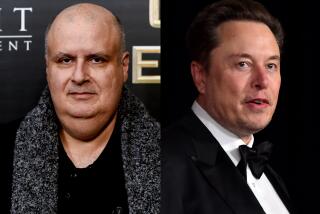Remembering the late, great electric car
- Share via
Given the problems wrought on the planet by the oil industry, geo-politics and massive pollution, it would be a dream come true if some inventor and auto company could come up with an electric car that runs on batteries, doesn’t consume fossil fuel and doesn’t pollute the environment.
What a glorious fantasy! Maddeningly, though, this particular dream happens to be true, a wondrous tale with an infuriating ending (at least so far).
There was just such an automobile: an electric car that ran on special batteries, had incredible acceleration and speed and required only recharging to keep running.
It was available in 1996: the General Motors EV1. (Another version of the electric car, the RAV4 EV, was available from Toyota.)
The EV1, which was leased rather than sold, was the product of a legendary designer, Paul MacCready. It was fast, clean and quiet, and its happy driver-leasers included Mel Gibson, Tom Hanks and Alexandra Paul of “Baywatch.”
Then, in 2000, GM suddenly began reversing direction, switching from electric car manufacturing back to gas-powered vehicles at its Lansing, Mich., plant.
Eventually GM reclaimed all the EV1s, and, despite organized protests by satisfied EV1 customers and fans, an offer to buy all the cars was refused and the vehicles were eventually hauled off to GM’s Arizona desert proving ground, crushed and destroyed.
Why?
That’s the “murder mystery” this film sets out to answer -- and pretty well does. Director-writer Chris Paine was one of those happy EV1 leasers and later the owner of a Toyota RAV4 EV, and his love for these electric cars has inspired this often fascinating picture.
In it, Paine tells the tale of the car’s invention and lays out a long list of suspects in its annihilation -- including oil companies, car companies, the government, the California Air Resources Board and its 1999-2004 chair, Alan C. Lloyd, and even American consumers, who, some argued, simply didn’t want the car.
The films ends up “convicting” some defendants (a few with mitigating circumstances) and “acquitting” others.
“Who Killed the Electric Car?” isn’t at all neutral. Paine is a passionate advocate of the electric car and a supporter of the California zero-emission-vehicle mandate, which helped create the EV1 market (before that mandate was later modified under pressure). He is obviously saddened and even incensed at its demise.
But “Electric Car” strikes me as fair. Paine gives his opponents their say, including GM’s representatives and Lloyd, the mild-mannered CARB chairman. There are dozens of interviewees, including Gibson (sporting a wild ZZ Top beard), Paul, EV1 drive system engineer Alan Cocconi, The Times auto critic Dan Neil, the inevitable Ralph Nader and the surprising Phyllis Diller (who recalls pre-1920 electric cars).
But, even though Paine’s sympathies are obvious, they help rather than hurt his film. Documentaries, from their earliest years, have a strong tradition of advocacy; it’s mostly Michael Moore’s more impassioned detractors who insist that nonfiction films are simply another form of the “neutral” evening TV news.
*
‘Who Killed the Electric Car?’
MPAA rating: PG for brief mild language
A Sony Pictures Classics release. Director Chris Paine. Producer Jessie Deeter. Cinematographer Thaddeus Wadleigh. Editors Michael Kovalenko, Chris A. Peterson. Music Michael Brook. Running time: 1 hour, 31 minutes.
At ArcLight Cinemas, 6360 Sunset Blvd., Hollywood (323) 464-4226; and the Landmark NuWilshire, 1314 Wilshire Blvd., Santa Monica, (310) 281-8223; opens Friday in other selected theaters.






